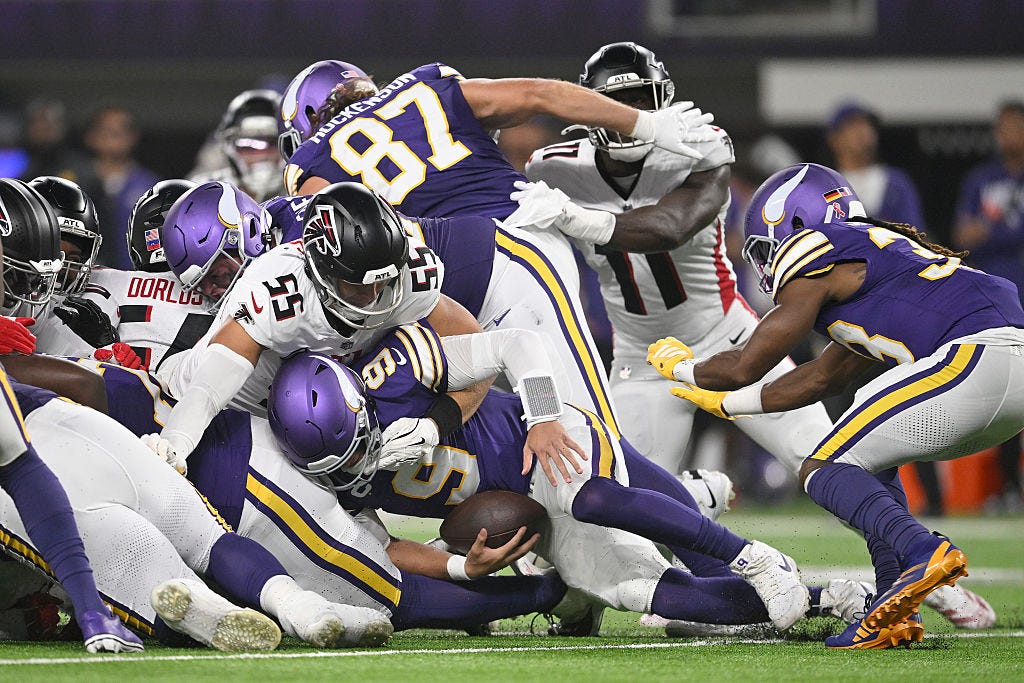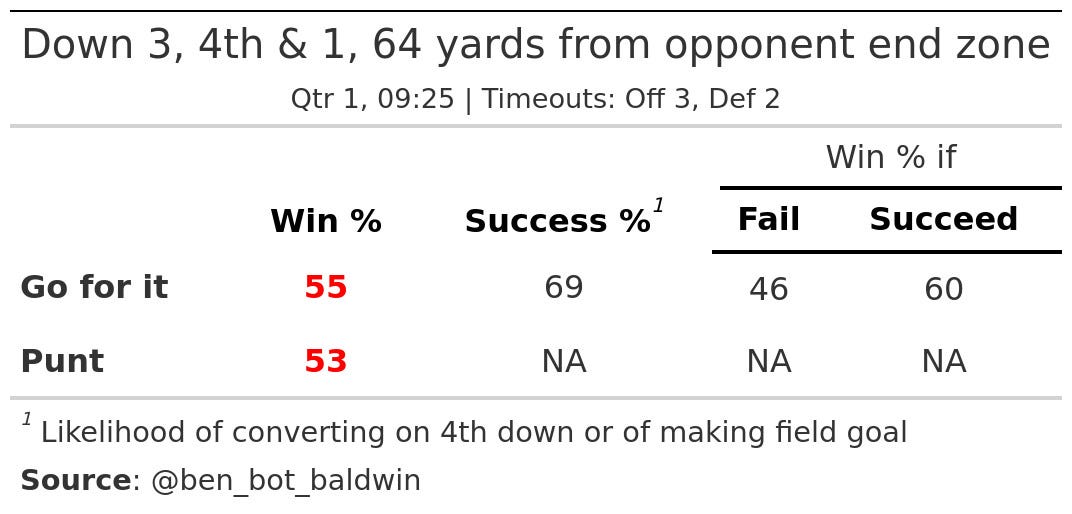Disasterclass: Taking Notes on the Vikings' Offensive Debacle Against the Falcons
Matt Fries goes drive by drive to figure out what went wrong with the Vikings offense — and whether or not these worries should plague fans going forward.
Of the many words for the Minnesota Vikings offensive performance against the Atlanta Falcons, “complete disaster” may be the most apt descriptor that doesn’t involve four-letter words.
Per RBSDM.com, the Vikings finished dead last in EPA/play on the week, averaging -0.458 EPA/play during the game. They averaged -0.606 EPA/dropback, which is the worst mark since Dallas averaged -0.745 EPA/dropback in Week 10 of 2024. Last year, the NFL only saw four games below the -0.600 EPA/dropback mark. Those games were started by Bryce Young, Andy Dalton, Cooper Rush, and Jameis Winston.
Put another way, only about 0.7% of all games have had a passing performance that bad.
The Vikings’ running game fared a little better than the passing game, but still performed well below average with -0.197 EPA/play.
The Vikings turned the ball over three times, with quarterback J.J. McCarthy throwing two interceptions and fumbling while taking an unblocked sack. If you want to include it, a failed QB sneak on fourth down could be counted as a fourth turnover.
Critical downs were also a major issue for the Vikings. They went 4-for-11 on 3rd down, which doesn’t look like the worst performance until you realize that all four 3rd down conversions came on the same drive. On 4th down, they went 1-for-2. After their success, they immediately got a holding penalty and punted on the next series of downs.
With results that look that bad, you may expect that the team was constantly behind the chains, trying to catch up after bad starts to drives, but that’s not really the case. The Vikings averaged 5.7 yards to go on 3rd down, a very reasonable mark.
They even converted their longest 3rd down attempt, a 19-yard strike from McCarthy to Adam Thielen on 3rd and 18. They only faced one other third down over 10 yards, a 3rd and goal from the 14 after starting the series on the 2-yard line.
This leads to an interesting juxtaposition where the Vikings were much more successful than their EPA/play would suggest. Their 40.4% success rate was 23rd on the week, and they actually ranked 3rd across the league with a 52.9% rushing success rate. The problem was that they couldn’t do it when it counted, and gained first downs with just 2 of their 6 rushing attempts with 3 or fewer yards to go (excluding the two sneaks).
Who’s responsible for the mess? After reviewing the tape, pretty much the entire offense. The Vikings had the ball 10 times and put points on the board just twice. Let’s go drive-by-drive to figure out what went wrong.
4th Down Failure
After allowing points to the Falcons to start the game, the Vikings wanted to respond on their first drive. McCarthy had a nice 3rd down scramble that nearly reached the first down marker, but was spotted short.
You could argue that Vikings’ HC Kevin O’Connell should have challenged the spot. There’s a screenshot that’s been going around of the ball on the ground at the down marker, but it’s notable that the ball is out of bounds in that picture. The rule spots the ball at the place it crosses the out of bounds line, which may still have been short. Throwing the red flag would risk a failed challenge, costly this early in the game.
I think O’Connell makes the right call not to challenge, and instead to try a QB sneak on 4th-and-1. Sneaks are a great play call with that short distance to go. Even though the Vikings were in their own territory, going for it was the right call analytically:
The problem, of course, was that McCarthy bobbled the snap on the sneak attempt. The Vikings’ OL appears to get enough push to make the yardage needed, but you can’t do that if you don’t have the football. Ultimately, McCarthy needs to handle this snap better:
It should be noted that Carson Wentz will probably be starting in place of McCarthy, as McCarthy suffered a high ankle sprain that is expected to sideline him for 2-4 weeks. I covered Wentz’s game in detail a couple of weeks ago. As we go through this piece, I’ll evaluate what I think would have happened if Wentz were the QB in each case, to try to gain an understanding of where the Vikings might end up with their temporary starter.
Wentz has botched taking a snap on a fourth-down QB sneak before, as an Indianapolis Colt in 2021 against the Seattle Seahawks. According to Stathead’s Game Play Finder, he also fumbled on a QB sneak in 2019 against the Giants, but that fumble occurred as he was reaching for the first down.
Third Down Sack
On the next drive, the Vikings ran twice to get it to 3rd-and-2. With a failed second-down run, they decided to drop back on third down. The play design is a spacing concept, which is a common quick game call in the NFL. The Vikings are doing this from a pseudo-bunch, with WRs Justin Jefferson, Adam Thielen, and Jalen Nailor close together, hoping to create traffic for the defense. On the back side, TE TJ Hockenson is helping the pass protection with a chip before releasing into a checkdown route. The route distribution looks like this:
As you can see, when McCarthy hits the top of his drop, he has Nailor open on his flat route, past the sticks. He’s looking right at the route and needs to throw this pass:
For whatever reason, McCarthy turned that opportunity down. In doing so, he allowed the rush to get home, leading to a sack. In his defense, McCarthy should have had more than a split second to make a decision, but rookie left guard Donovan Jackson allowed pressure on a stunt. Let’s look at how the protection broke down next.
The Falcons do a good job of presenting six rush threats along the line of scrimmage. Even though linebacker Divine Deablo drops into coverage, his presence on the line of scrimmage forces the Vikings into what’s known as “5-0” or man-to-man protection. Each lineman is responsible for blocking a specific player. The assignments are pretty clear, with Hockenson and running back Jordan Mason combining to block the player that’s off screen.
The Falcons run a pair of stunts between their DEs and DTs, which is intended to attack the one-for-one protection. Because each player is responsible for a full defender, it is more difficult to pass off stunts than if they were in “area” or “zone” protection, where they are assigned a region of the field to identify threats and block them.
A stunt pass off failure is exactly what happens. Defensive tackle Ruke Orhorhoro, No. 98, does a good job selling his rush, as he gets vertical upfield attacking Jackson’s outside shoulder. This forces Jackson to get his hands on Orhorhoro before he can recognize and adjust to the stunt from edge rusher James Pearce Jr., No. 27. Pearce is too quick for Jackson, beating him to the inside and sacking McCarthy.
Ultimately, this play was a sack because of a missed read by McCarthy AND a quick protection failure. It could have succeeded if McCarthy had been able to progress through his reads, or if he’d thrown the ball to the right spot on time. I’d put this on both McCarthy and Jackson:
Would Carson Wentz make this throw? He was pretty efficient at throwing to out routes in his last two starts. He may be willing to stick with Nailor and fire the throw.
[Ed. Note: Per Next Gen Stats’ data, Wentz’s time to throw since 2021 on flat/out routes between 0 and 8 yards in depth was 2.58 seconds, faster than the NFL average in 2.63. He generated plus-0.17 expected points per attempt on those throws, above the NFL average of plus-0.12.]
Going Backwards on the Goal Line
On the next drive, the Vikings look like they might have figured it out. They took 13 plays, consistently executing on 3rd down, and ended up with 1st and goal from the 2 after a nice anticipation out route from McCarthy to Nailor.
Keep reading with a 7-day free trial
Subscribe to Wide Left to keep reading this post and get 7 days of free access to the full post archives.










